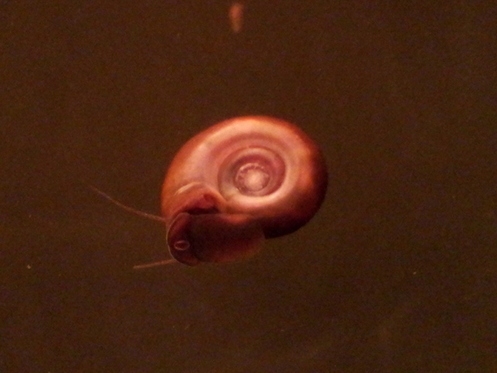
Ramshorn Snail (Planorbis rubrum)


Common names: Ramshorn snail
Family: Planorbidae
Minimum tank size: No minimum
Hardiness: Easy
Aggressiveness: Peacefull
Distribution: Can be found on most continents throughout the world.
Diet: Algae, uneaten fish food, dead fish, dead plants.
Family: Planorbidae
Minimum tank size: No minimum
Hardiness: Easy
Aggressiveness: Peacefull
Distribution: Can be found on most continents throughout the world.
Diet: Algae, uneaten fish food, dead fish, dead plants.
Ramshorn snails are usually found in two different skin colorations: black or red.
Unlike other snails that have a green or black skin coloration, the red Ramshorns have blood containing hemoglobin and the skin lack the dark pigment called “melanin”. Consequently, the red Ramshorns have a red skin, which is the color of their blood. Their shells can range in color from varying shades of browns to deep black. Some can even be translucent. It is belived that the darker colors are the result of dietary materials that are usually found in ponds or swampy areas (usually not available in aquarium).
Ramshorn snails are lung breathers that use large folds of skin to trap air in a pulmonary sac located in the outer whirl of the shell. It is sometime possible to see the pulmonary sac by placing the snail in front of a light (look for an air filled space).
They lay eggs in globules that contain about a dozen or so eggs. The globules are translucent, so it is possible to visually see the new snails develop in size. The newborn snails are clear-white.
Benefits of Ramshorn snails
Many aquarist consider the Ramshorn snail to be a good addition to the clean up crew. They have a strong appetite and will get rid of all algae in no time. They also clean the surface of the plants. They will travel around the aquarium, eating rotting leaves, algae and also carcasses that have been missed.
Control Methods
Overfeeding is the number one cause of snail outbreaks. If you see more and more snails in your tank, then there are good probability that you are overfeeding. Before to try any other method of control, you can simply reduce feeding a little. This should help lot.
Some aquarium species will eat ramshorn snails. Some of the best fish for Ramshorn control are the members of the genus botia such as the well known clown loach. Bettas, crayfish, most gouramis and apple snails will also prey on these snails.
Since Ramshorn snails are often introduced in the aquarium as egg bundles hidden in newly acquired plants, treating the plants can help lot. One way to treat hardier plants is to soak them in a solution of water and chlorine bleach for 10 minutes (20 parts of water, 1 part of bleach). When treating my plants with bleach, I always avoid to treat the roots to not damaging them. A bleach bath should always followed by an other bath with water containing a dechlorinating agent. A more gentle treatment calls for 5-10 tablespoons of alum to 1 gallon of water for 2-3 days. An other way to treat the plants is to quarantine them and treat with snail poisons. This way, you don’t have to use poisons in the main show tank. I know that some will tip the plant in saltwater for 5 minutes to kill the snails or eggs but I don’t know how much salt they use for that.
Manual removal can also be an effective way to get rid of a snail infestation. To help removing the snail, some aquarist will use lettuce of cucumber to bait them. There are snail traps available to buy. These traps work quite simply by adding some food into a chamber that the snails can get into but can’t get out. An other effective way to help removing the snails manually is to stop the aeration. The snails need air so they will soon climb to upper levels in order to breath. It is very easy to take them out as they reach the surface. Planted tank may not have an air pump since the plants alone are enough to supply air. In this case leaving the light off for some time (plants only produce air during day time) might help.
Unlike other snails that have a green or black skin coloration, the red Ramshorns have blood containing hemoglobin and the skin lack the dark pigment called “melanin”. Consequently, the red Ramshorns have a red skin, which is the color of their blood. Their shells can range in color from varying shades of browns to deep black. Some can even be translucent. It is belived that the darker colors are the result of dietary materials that are usually found in ponds or swampy areas (usually not available in aquarium).
Ramshorn snails are lung breathers that use large folds of skin to trap air in a pulmonary sac located in the outer whirl of the shell. It is sometime possible to see the pulmonary sac by placing the snail in front of a light (look for an air filled space).
They lay eggs in globules that contain about a dozen or so eggs. The globules are translucent, so it is possible to visually see the new snails develop in size. The newborn snails are clear-white.
Benefits of Ramshorn snails
Many aquarist consider the Ramshorn snail to be a good addition to the clean up crew. They have a strong appetite and will get rid of all algae in no time. They also clean the surface of the plants. They will travel around the aquarium, eating rotting leaves, algae and also carcasses that have been missed.
Control Methods
Overfeeding is the number one cause of snail outbreaks. If you see more and more snails in your tank, then there are good probability that you are overfeeding. Before to try any other method of control, you can simply reduce feeding a little. This should help lot.
Some aquarium species will eat ramshorn snails. Some of the best fish for Ramshorn control are the members of the genus botia such as the well known clown loach. Bettas, crayfish, most gouramis and apple snails will also prey on these snails.
Since Ramshorn snails are often introduced in the aquarium as egg bundles hidden in newly acquired plants, treating the plants can help lot. One way to treat hardier plants is to soak them in a solution of water and chlorine bleach for 10 minutes (20 parts of water, 1 part of bleach). When treating my plants with bleach, I always avoid to treat the roots to not damaging them. A bleach bath should always followed by an other bath with water containing a dechlorinating agent. A more gentle treatment calls for 5-10 tablespoons of alum to 1 gallon of water for 2-3 days. An other way to treat the plants is to quarantine them and treat with snail poisons. This way, you don’t have to use poisons in the main show tank. I know that some will tip the plant in saltwater for 5 minutes to kill the snails or eggs but I don’t know how much salt they use for that.
Manual removal can also be an effective way to get rid of a snail infestation. To help removing the snail, some aquarist will use lettuce of cucumber to bait them. There are snail traps available to buy. These traps work quite simply by adding some food into a chamber that the snails can get into but can’t get out. An other effective way to help removing the snails manually is to stop the aeration. The snails need air so they will soon climb to upper levels in order to breath. It is very easy to take them out as they reach the surface. Planted tank may not have an air pump since the plants alone are enough to supply air. In this case leaving the light off for some time (plants only produce air during day time) might help.